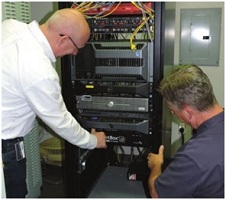
As end users and their professional video surveillance technicians work to identify all the options in migrating a customer from analog technology, it should be clear there is more at stake than simply removing legacy coaxial cable and installing new Category-6 unshielded twisted pair (UTP) for IP. According to NVT Phybridge CEO John Croce, one of the biggest mistakes that installing security contractors and their clients make when moving to an IP-based surveillance strategy is there is simply not enough forethought given to the video system’s effect on the client’s LAN.
For starters, think cybersecurity. “We’re hearing more and more about security compromises and breaches among some of the largest companies in the world where you would think they would have a lockdown security environment,” says Croce. “The first thing [an integrator] must do is understand how to design a LAN platform that will enable [the end user] to migrate to an IP-based end point and app without compromising their business, without compromising the network performance, but doing it in a manner that is cost effective.”
The question, Croce explains, becomes how? “This is where we begin by understanding their current state before moving to IP.” Croce says there are three distinct networks that must be examined in order to determine what’s necessary to accommodate a fully IP-enabled network. “This is the network that supports the devices which employees use to get access to business intelligence and processes to deliver an end-customer experience, driving the profitability of that business,” he says.
The second network is the communication network, Croce says, or the network supporting the telephony system. “We have seen businesses migrating their telephony network also to IP. Many customers partially migrate to an IP-based telephony network because of the value and the unified communications.”
Among the biggest challenges faced by end users? The physical infrastructure requirements to actually deploy IP telephony, ensuring there is a quality of service and a good user experience within a budget environment due to all the infrastructure changes.
The third network is the physical security network which, of course, protects the core business, the business’ core network, as well as the capabilities of the firm’s valued employees. Therefore, Croce explains, it is essential the system integrator understand before migrating to IP what the physical network will look like.










